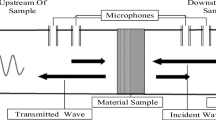Abstract
In order to dissipate sound which passes through an open awning window, we have developed a hybrid absorber made of a modified Helmholtz resonator with perforated foam. Generally, acoustic absorbers are divided into two major categories. The first one is porous materials which dissipate the acoustic wave in a visco-inertial form and heat. The second category is systems which absorb the energy of the acoustic wave by resonance. The aim of this work was to design a hybrid absorber which incorporates the benefits of the two categories for both high frequencies (conventional foam) and low frequencies (resonator). After describing the concept and the principles, we present the prototype which was built and tested under laboratory conditions between two reverberant rooms to attenuate the sound when an awning window is open. The prototype allows reduction of noise transmission (up to 6 dB) at low and high frequencies.
Similar content being viewed by others
References
Allard JF, Atalla N (2009). Propagation of Sound in Porous Media, Modelling Sound Absorbing Materials, 2nd edn. Chichester, UK: John Wiley & Sons.
Beranek LL (1942). Acoustic impedance of Porous Materials. Journal of the Acoustical Society of America, 13: 248–260.
Bernhard RJ, Hall HR, Jones JD (1992). Adaptive-passive noise control. In: Proceedings of Inter-Noise 92, Toronto, Canada, pp. 427–430.
Bolt RH (1947). On the design of perforated facings for acoustic materials. Journal of the Acoustical Society of America, 19: 917–921.
Callaway DB, Remer LG (1952). The use of perforated facings in designing low frequency resonant absorbers. Journal of the Acoustical Society of America, 24: 309–312.
Champoux Y, Allard JF (1991). Dynamic tortuosity and bulk modulus in air-saturated porous media. Journal of Applied Physics, 70: 1975–1979.
Chanaud RC (1994). Effects of geometry on the resonance frequency of Helmholtz resonators. Journal of Sound and Vibration, 178: 337–348.
Crocker MJ, Arenas JP (2007). Use of sound-absorbing materials. In: Crocker MJ (Ed), Hanbook of Noise and Vibration Control, Chapter 57. New York: John Wiley & Sons.
Davern WA (1977). Perforated facings backed with porous materials as sound absorbers—An experimental study. Applied Acoustics, 10: 85–112.
Gourdon E, Seppi M (2010). On the use of porous inclusions to improve the acoustical response of porous materials: Analytical model and experimental verification. Applied Acoustics, 71: 283–298.
Griffin S, Lane SA, Huybrechts S (2000). Coupled Helmholtz resonators for acoustic attenuation. Journal of Vibration and Acoustics, 123: 11–17.
Guignouard P, Meisser M, Allard JF, Rebillard P, Depollier C (1991). Prediction and measurement of the acoustical impedance and absorption coefficient at oblique incidenced of porous layers with perforated facings. Noise Control Engineering Journal, 36: 129–135.
Ingard U (1953). On the theory and design of acoustic resonators. Journal of the Acoustical Society of America, 25: 1037–1061.
Johnson DL, Koplik J, Dashen R (1987). Theory of dynamic permeability and tortuosity in fluid-saturated porous media. Journal of Fluid Mechanics, 176: 379–402.
Olny X, Boutin C (2003). Acoustical wave propagation in double porosity media. Journal of the Acoustical Society of America, 114: 73–89.
Panneton R, Olny X (2006). Acoustical determination of the parameters governing viscous dissipation in porous media. Journal of the Acoustical Society of America, 119: 2027–2040.
Rayleigh (1870). On the theory of resonators. Philosophical Transactions of the Royal Society, 161: 77–118.
Sgard F, Olny X, Atalla N, Castel F (2005). On the use of perforations to improve the sound absorption of porous materials. Applied acoustics, 66: 625–651.
Tang SK (2005). On Helmholtz resonators with tapered necks. Journal of Sound and Vibration, 279: 1085–1096.
Acknowledgements
This work was performed within the framework of the project OVI-SOLVE (ANR-11-VILD-0007) and in the framework of the LABEX CeLyA (ANR-10-LABX-0060) of Université de Lyon.
Author information
Authors and Affiliations
Corresponding author
Rights and permissions
About this article
Cite this article
Gourdon, E., El Mankibi, M., Issoglio, R. et al. Silencer design for awning windows: Modified Helmholtz resonators with perforated foam. Build. Simul. 10, 677–685 (2017). https://doi.org/10.1007/s12273-017-0365-0
Received:
Revised:
Accepted:
Published:
Issue Date:
DOI: https://doi.org/10.1007/s12273-017-0365-0




